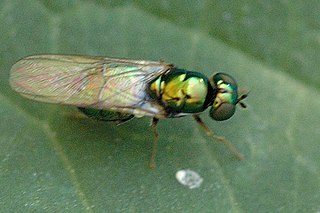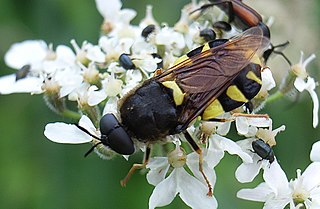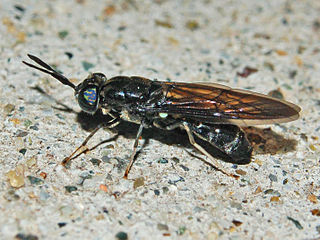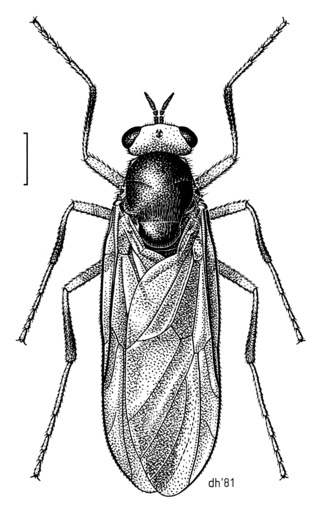
The soldier flies are a family of flies. The family contains over 2,700 species in over 380 extant genera worldwide. Larvae are found in a wide array of locations, mostly in wetlands, damp places in soil, sod, under bark, in animal excrement, and in decaying organic matter. Adults are found near larval habitats. They are diverse in size and shape, though they commonly are partly or wholly metallic green, or somewhat wasplike mimics, marked with black and yellow or green and sometimes metallic. They are often rather inactive flies which typically rest with their wings placed one above the other over the abdomen.

Microchrysa is a genus of soldierfly belonging to the family Stratiomyidae. There has been some confusion with the synonym Chrysomyia of Macquart, 1834, causing some members of the genus Chrysomya of Robineau-Desvoidy, 1830 to be placed erroneously in this genus.

Stratiomyini is a tribe of flies in the family Stratiomyidae.

Zabrachia is a genus of soldier flies in the family Stratiomyidae. Adults can be distinguished from other Pachygastrinae by the fused R4 and R5 wing veins. Females have been collected during oviposition into pine wood, and larvae are known to live under the bark of coniferous trees, including lodgepole pine, ponderosa pine, and Douglas fir.

Pachygaster is a genus of flies in the family Stratiomyidae.

Oxycera is a genus of flies in the family Stratiomyidae.

Nemotelus is a genus of soldier flies in the family Stratiomyidae. Nemotelus is known from the Nearctic, Afrotropical and the Palaearctic regions.

Chorisops is a genus of flies in the family Stratiomyidae.

Beris is a genus of flies in the family Stratiomyidae. They are small flies with reduced palpi. The scutellum has spines and the abdomen has seven visible segments. Their eyes are contiguous in the male.

Actina is a genus of flies in the family Stratiomyidae.

Stratiomyinae is a subfamily of flies in the family Stratiomyidae.

Beridinae is a subfamily of soldier flies in the family Stratiomyidae.

Pachygastrinae is a subfamily of flies in the family Stratiomyidae.

Sarginae is a subfamily of soldier flies in the family Stratiomyidae.

Hermetia is a genus of flies of the family Stratiomyidae.

Cyphomyia is a genus of flies in the subfamily Clitellariinae.

Allognosta is a genus of soldier flies in the family Stratiomyidae.

Inopus is a genus of soldier flies in the family Stratiomyidae.
Brachycara is a genus of flies in the family Stratiomyidae.
Aulana is a genus of flies in the family Stratiomyidae.















